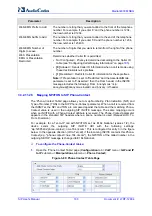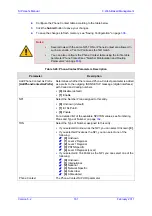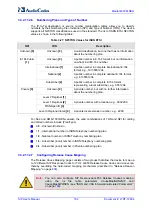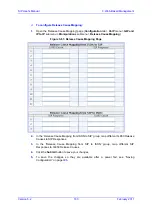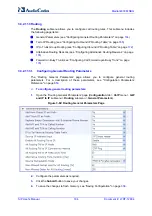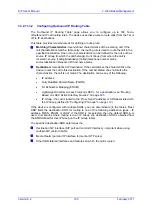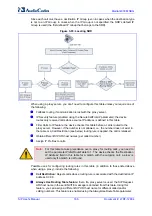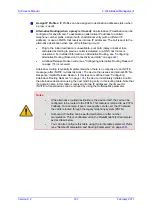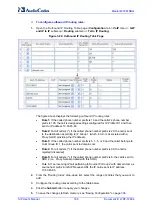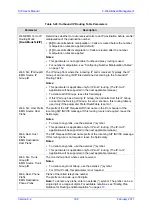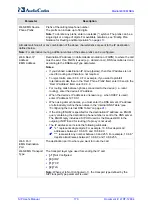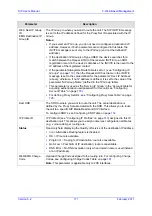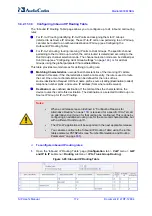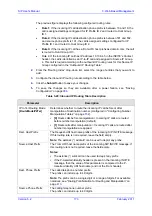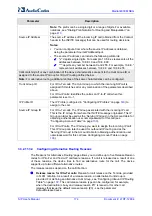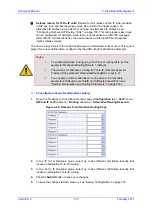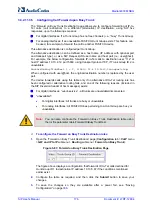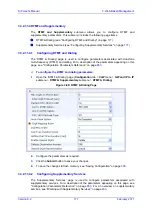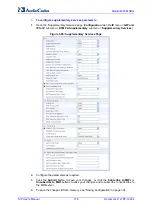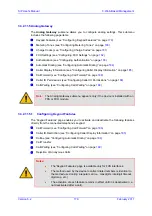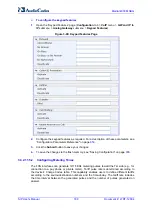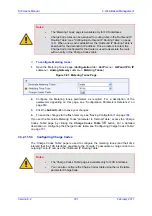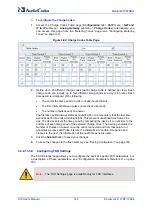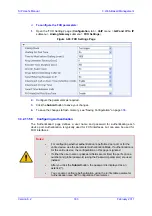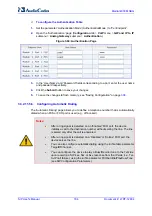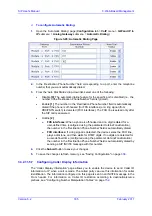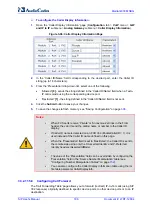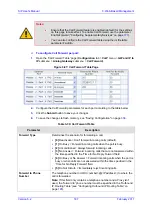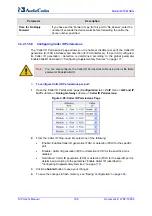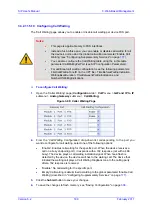
SIP User's Manual
174
Document #: LTRT-12804
Mediant 800 MSBG
Parameter
Description
Note:
The prefix can be a single digit or a range of digits. For available
notations, see ''Dialing Plan Notation for Routing and Manipulation'' on
page
Source IP Address
The source IP address of the incoming IP call (obtained from the Contact
header in the INVITE message) that can be used for routing decisions.
Notes:
You can configure from where the source IP address is obtained,
using the parameter SourceIPAddressInput.
The source IP address can include the following wildcards:
9
"x": depicts single digits. For example, 10.8.8.xx represents all the
addresses between 10.8.8.10 and 10.8.8.99.
9
"*": depicts any number between 0 and 255. For example, 10.8.8.*
represents all addresses between 10.8.8.0 and 10.8.8.255.
Calls matching all or any combination of the above characteristics are sent to the Hunt Group ID or
assigned to the source IP Group for IP-to-IP routing defined below.
Note:
For alternative routing, additional entries of the same characteristics can be configured.
Trunk Group ID
For IP-to-Tel calls: The Hunt Group to which the incoming SIP call is
assigned if it matches all or any combination of the parameters described
above.
For IP-to-IP calls: Identifies the call as an IP-to-IP call when this
parameter is set to -1.
IP Profile ID
The IP Profile (configured in ''Configuring IP Profiles'' on page
) to
assign to the call.
Source IP Group ID
For IP-to-Tel calls: The IP Group associated with the incoming IP call.
This is the IP Group from where the INVITE message originated. This IP
Group can later be used as the 'Serving IP Group' in the Account table for
obtaining authentication user name/password for this call (see
''Configuring Account Table'' on page
For IP-to-IP calls: The IP Group you want to assign the incoming IP call.
This IP Group can later be used for outbound IP routing and as the
'Serving IP Group' in the Account table for obtaining authentication user
name/password for this call (see Configuring Account Table on page
).
3.3.2.11.3.4 Configuring Alternative Routing Reasons
The 'Reasons for Alternative Routing' page allows you to define up to five Release Reason
codes for IP-to-Tel and Tel-to-IP call failure reasons. If a call is released as a result of one
of these reasons, the device tries to find an alternative route for the call. The device
supports up to two different alternative routes.
The release reasons depend on the call direction:
Release reason for IP-to-Tel calls:
Reason for call release on the Tel side, provided
in Q.931 notation. As a result of a release reason, an alternative Hunt Group is
provided. For defining an alternative Hunt Group, see ''Configuring Inbound IP Routing
Table'' on page
. This call release reason type can be configured, for example,
when the destination is busy and release reason #17 is issued or for other call
releases that issue the default release reason (#3) - see the parameter
DefaultReleaseCause.
Summary of Contents for Mediant 800 MSBG
Page 2: ......
Page 366: ...SIP User s Manual 366 Document LTRT 12804 Mediant 800 MSBG Reader s Notes ...
Page 372: ...SIP User s Manual 372 Document LTRT 12804 Mediant 800 MSBG Reader s Notes ...
Page 390: ...SIP User s Manual 390 Document LTRT 12804 Mediant 800 MSBG Reader s Notes ...
Page 404: ...SIP User s Manual 404 Document LTRT 12804 Mediant 800 MSBG Reader s Notes ...
Page 616: ...SIP User s Manual 616 Document LTRT 12804 Mediant 800 MSBG Reader s Notes ...
Page 636: ...SIP User s Manual 636 Document LTRT 12804 Mediant 800 MSBG Reader s Notes ...
Page 652: ...SIP User s Manual 652 Document LTRT 12804 Mediant 800 MSBG Reader s Notes ...
Page 886: ...SIP User s Manual 886 Document LTRT 12804 Mediant 800 MSBG Reader s Notes ...

